

From my friend in Cairo: 1 Minute News On Twitter About Egypt #Jan25 - It's fast! Timeline: Egypt unrest - Middle East. January 2011: Activists in Egypt call for an uprising in their own country, to protest against poverty, unemployment, government corruption and the rule of president Hosni Mubarak, who has been in power for three decades.
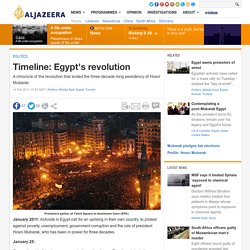
January 25: On a national holiday to commemorate the police forces, Egyptians take to the streets in large numbers, calling it a "day of rage". Thousands march in downtown Cairo, heading towards the offices of the ruling National Democratic Party, as well as the foreign ministry and the state television. Similar protests are reported in other towns across the country. After a few hours of relative calm, police and demonstrators clash; police fire tear gas and use water cannons against demonstrators crying out "Down with Mubarak'' in Cairo's main Tahrir Square. Protests break out in the Mediterranean city of Alexandria, the Nile Delta cities of Mansura and Tanta and in the southern cities of Aswan and Assiut, witnesses say.
Ramy Yaacoub: Confirmed: Christians were... Egypt/Main Page - We Re-Build. Protests in Egypt - live updates. Egypt's biggest demonstrations yet are planned today following Friday prayers, in the face of an increasing crackdown by the authorities.

Overnight several senior members of the Muslim Brotherhood were arrested after the organisation pledged to take part in the demonstrations for the first time. To date the demonstrations have been largely secular, as they were in Tunisia. Egypt Shuts Off Tech, Tries to Shut Up Protesters. The Egyptian government, facing mass protests in the nation's streets by citizens calling for regime change, has shut off the Internet, SMS, and BlackBerry service--and may have shuttered some mobile phone systems too.

Now the population is turning to 20th century solutions. Earlier this week we wrote about mass pro-democracy protests on the streets of Egypt's cities, which were organized--at least in part--using social media like Twitter and Facebook, and with the same sites, along with Twitpic and its peers being used to share news and video and photo evidence about real-time events. The government resisted the protests physically on the streets, but also launched a digital offensive--first shutting off access to Twitter on Wednesday, then Facebook on Thursday. Now Internet access across the whole nation has been shut off, as the Net traffic volume chart from Arbor Networks embedded here shows. Egypt Leaves the Internet. Thanks to all for great comments and questions.
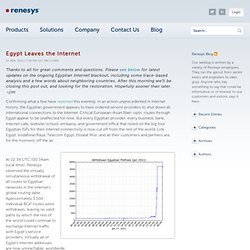
Please see below for latest updates on the ongoing Egyptian Internet blackout, including some trace-based analysis and a few words about neighboring countries. After this morning we’ll be closing this post out, and looking for the restoration. Hopefully sooner than later. –jim Confirming what a few have reported this evening: in an action unprecedented in Internet history, the Egyptian government appears to have ordered service providers to shut down all international connections to the Internet. At 22:34 UTC (00:34am local time), Renesys observed the virtually simultaneous withdrawal of all routes to Egyptian networks in the Internet’s global routing table. This is a completely different situation from the modest Internet manipulation that took place in Tunisia, where specific routes were blocked, or Iran, where the Internet stayed up in a rate-limited form designed to make Internet connectivity painfully slow.
Update (3:06 UTC Friday) Access the internet in Egypt now! Egypt Revolution & Internatl. Impact. Cable Viewer. Viewing cable 09CAIRO1447, RECENT GOE ACTIONS TO SUPPRESS CRITICAL OPINION.
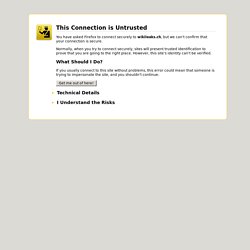
Cable Viewer. Viewing cable 10CAIRO147, A/S POSNER PRESSES GOE ON POLICE BRUTALITY, NGO Understanding cables Every cable message consists of three parts: The top box shows each cables unique reference number, when and by whom it originally was sent, and what its initial classification was.The middle box contains the header information that is associated with the cable.
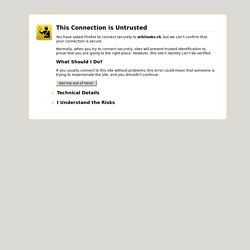
It includes information about the receiver(s) as well as a general subject.The bottom box presents the body of the cable. The opening can contain a more specific subject, references to other cables (browse by origin to find them) or additional comment. This is followed by the main contents of the cable: a summary, a collection of specific topics and a comment section. Cable Viewer. Viewing cable 10CAIRO181, Scenesetter for Admiral Mullen Understanding cables Every cable message consists of three parts: The top box shows each cables unique reference number, when and by whom it originally was sent, and what its initial classification was.The middle box contains the header information that is associated with the cable.
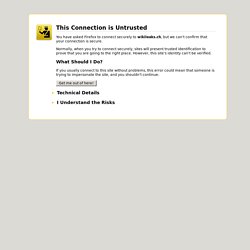
It includes information about the receiver(s) as well as a general subject.The bottom box presents the body of the cable. The opening can contain a more specific subject, references to other cables (browse by origin to find them) or additional comment. This is followed by the main contents of the cable: a summary, a collection of specific topics and a comment section. To understand the justification used for the classification of each cable, please use this WikiSource article as reference. Discussing cables If you find meaningful or important information in a cable, please link directly to its unique reference number.